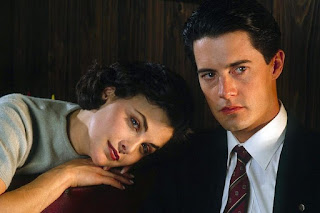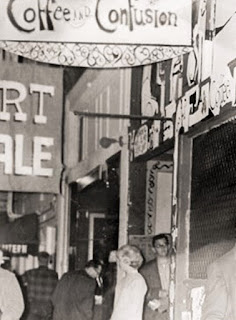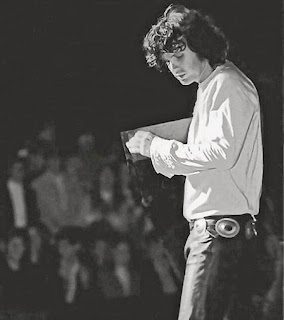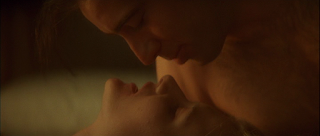Jim Morrison just leans against the wall, well posed. Same interested eyes for the blonde girl that I got. Morrison's into some heavy nonverbal projection with the girl. Courtship without words. This cat is knocking me off without saying anything. Morrison's got the wine for the rest of the night, practically a full bottle. Jim stares at me. Just a little bit hostile. Watchful. I get a rush. So intense from LSD that I stumble, feeling the floor sinking out from under my legs. Vertigo. Morrison's hand hits my chest, steadies me, then pushes me to the wall so I don't dive forward on my face. "Peaking on acid?" "Mount McKinley," I admit, too suddenly disoriented. Got the feeling he's peaking two times higher than I am and I am already knocking on the gates of heaven. Morrison keeps his head turned a little, so that the sounds of the sea are always clear in his ears, as though he expects some other sound than the splashing of the waves.
It's Morrison's world, some unseen place across the dark sea. I see two chicks thumbing it in front of some kind of army/navy store, something appropriate like that. "They got the secret of fire," says Morrison with a grin. We finally pull up to the two chicks who are thumbing. Morrison opens the door for them and they crawl into the back seat. One of the girls, Sandy, is a real looker. Blond the way girls can get only in the California sun. Tall with wicked long legs you could sense through her tight blue jeans. "Far out," says Sandy, blinking her cat-cold green eyes. "We'll go anywhere you want," says Morrison as I start the car moving. I look back at Morrison. He's grinning like a Cheshire cat discovering downers, happy as a cocained cobra. Heading down Laurel Canyon, a mean twisting snake of downhill road. I quietly go mad. I'm hornier than a hot rabbit with socks on. I shouldn't team up with this kind of guy. I quietly tear my fingernails out. If I get any hornier, I could defy gravity. I can feel Morrison and Sandy's pleasure pumps all up and down my spine. That same hard kick you get from rock and roll. Silence from the back seat and exhausted breathing.
Morrison looks around. "Where the hell are we?" He's so high he's almost glowing in the dark. Morrison is delivering a speech he's given before: "Art is the greatest enslavement of all. Art obscures and blinds the imprisoned, they never see the walls of their frigging cages because art keeps them silent, awed, distracted, and finally, indifferent. Art is the exercise wheel in the cage that keeps the rat from going crazy and dying too soon." We argue. I´m for Malibu. Morrison wants to go to Venice Beach. Something about Jean-Luc Godard and a weekend. "I'm bored," says Deirdre. Morrison is bored of her being bored: "Deirdre, you're the girl with the graveyard heart." "I'm the girl who's sick of this writing bulishit. Poetry is for faggots." "Faggots are for faggots," says Morrison, not looking at her. She laughs at me and at Morrison. "I made you feel like you loved me," she says, absolutely merciless, "and I didn't mean one frigging bit of it." She smiles and it's cold and evil and I know she's the only one who ever had control. I watch her walking away down the beach like she owns it. The sea breeze blows her hair out behind her like a flag covered with honey. She's so beautitul it makes you ache, the most beautiful girl I've ever seen. Morrison's standing beside me suddenly. He puts his hand on my shoulder, watching me watch her walk away. "A cold girl'll kill you in a darkened room," he says. I nod, remembering what I always thought I knew.
Me, I was Philip Marlowe, doing a Dick Powell scene from Raymond Chandler's Murder, My Sweet. You know the one I mean. Somebody saps him with a blackjack and Marlowe/Powell says, "A black pool opened at my feet and I dove in." "I have seen the future and I won't go," says Morrison. He stares at the sky as if he sees the words up there somewhere: "We all look for our assassins and we say one thing but mean, probably at the back of it all: We want to be loved. So bury us in empty swimming pools! Bury us in empty swimming pools because we want to make love to the world and die in a place that has our name on it where no one can touch us or take our name away." Morrison is putting it all down on paper. Future scribbled hastily in the heat of our John F. Kennedy youth. "The future is a world that tries to live without the engine of the heart," writes Morrison.
Morrison looks depressed. "I been chasing her all night and I can't get to her." "You can't get her?" Now I'm really surprised. "What's wrong with her?" "Nothing," says Morrison, reaching out to take a joint from a roadie. Lots of band people here tonight. "She drives me crazy," says Morrison. I hear what he says and it registers. I knew this about him all along. He's a human being in secret. "You know who she is?" asks Morrison, staring at Pam: "She's the girl of summer. The Girl! If you get to her, in love, winter will never come." It's obvious to me this girl has him running in circles. Morrison disappears into the cold, uncaring heart of the party. And I forget him too. I don't even see the party anymore. —"Burn Down the Night" (1982) by Craig Kee Strete
HWY (1969), Jim Morrison’s hitchhiker-turned-killer tale seems to have been inspired by haunting images that had stayed with him since childhood, and by a 1953 film noir B-movie directed by Ida Lupino, called "The Hitch-Hiker". Morrison told writer Howard Smith (in November 1969, when he’d finished working on HWY) that he thought it was a “very beautiful film” about a person who “comes down out of the mountains and hitchhikes his way through the desert into a modern city, which happened to be L.A., and that’s where it ends.” Frank Lisciandro worked on editing the film, with Morrison’s input, in an office upstairs from Themis, Morrison’s girlfriend Pamela Courson’s clothing boutique, in the Clear Thoughts Building. The final edit was shown to friends, associates, and movie critics at a few private screenings during the winter of ’69, spring of ’70, including one screening held at the Granada Theatre inside the 9000 Bldg., on Sunset Blvd., where the final scene in the film takes place.
HWY had its official world premiere at the Orpheum Theatre during the aptly-named “Jim Morrison Film Festival” in Vancouver, British Columbia, Canada on March 27, 1970. Morrison, however, due to legal problems he was facing at the time, was unable to attend the midnight screening of the film. HWY was also submitted to the San Francisco International Film Festival but it was rejected for unknown reasons. It was never publicly shown again during Morrison’s lifetime.
Morrison looks around. "Where the hell are we?" He's so high he's almost glowing in the dark. Morrison is delivering a speech he's given before: "Art is the greatest enslavement of all. Art obscures and blinds the imprisoned, they never see the walls of their frigging cages because art keeps them silent, awed, distracted, and finally, indifferent. Art is the exercise wheel in the cage that keeps the rat from going crazy and dying too soon." We argue. I´m for Malibu. Morrison wants to go to Venice Beach. Something about Jean-Luc Godard and a weekend. "I'm bored," says Deirdre. Morrison is bored of her being bored: "Deirdre, you're the girl with the graveyard heart." "I'm the girl who's sick of this writing bulishit. Poetry is for faggots." "Faggots are for faggots," says Morrison, not looking at her. She laughs at me and at Morrison. "I made you feel like you loved me," she says, absolutely merciless, "and I didn't mean one frigging bit of it." She smiles and it's cold and evil and I know she's the only one who ever had control. I watch her walking away down the beach like she owns it. The sea breeze blows her hair out behind her like a flag covered with honey. She's so beautitul it makes you ache, the most beautiful girl I've ever seen. Morrison's standing beside me suddenly. He puts his hand on my shoulder, watching me watch her walk away. "A cold girl'll kill you in a darkened room," he says. I nod, remembering what I always thought I knew.
Me, I was Philip Marlowe, doing a Dick Powell scene from Raymond Chandler's Murder, My Sweet. You know the one I mean. Somebody saps him with a blackjack and Marlowe/Powell says, "A black pool opened at my feet and I dove in." "I have seen the future and I won't go," says Morrison. He stares at the sky as if he sees the words up there somewhere: "We all look for our assassins and we say one thing but mean, probably at the back of it all: We want to be loved. So bury us in empty swimming pools! Bury us in empty swimming pools because we want to make love to the world and die in a place that has our name on it where no one can touch us or take our name away." Morrison is putting it all down on paper. Future scribbled hastily in the heat of our John F. Kennedy youth. "The future is a world that tries to live without the engine of the heart," writes Morrison.
Morrison looks depressed. "I been chasing her all night and I can't get to her." "You can't get her?" Now I'm really surprised. "What's wrong with her?" "Nothing," says Morrison, reaching out to take a joint from a roadie. Lots of band people here tonight. "She drives me crazy," says Morrison. I hear what he says and it registers. I knew this about him all along. He's a human being in secret. "You know who she is?" asks Morrison, staring at Pam: "She's the girl of summer. The Girl! If you get to her, in love, winter will never come." It's obvious to me this girl has him running in circles. Morrison disappears into the cold, uncaring heart of the party. And I forget him too. I don't even see the party anymore. —"Burn Down the Night" (1982) by Craig Kee Strete
HWY (1969), Jim Morrison’s hitchhiker-turned-killer tale seems to have been inspired by haunting images that had stayed with him since childhood, and by a 1953 film noir B-movie directed by Ida Lupino, called "The Hitch-Hiker". Morrison told writer Howard Smith (in November 1969, when he’d finished working on HWY) that he thought it was a “very beautiful film” about a person who “comes down out of the mountains and hitchhikes his way through the desert into a modern city, which happened to be L.A., and that’s where it ends.” Frank Lisciandro worked on editing the film, with Morrison’s input, in an office upstairs from Themis, Morrison’s girlfriend Pamela Courson’s clothing boutique, in the Clear Thoughts Building. The final edit was shown to friends, associates, and movie critics at a few private screenings during the winter of ’69, spring of ’70, including one screening held at the Granada Theatre inside the 9000 Bldg., on Sunset Blvd., where the final scene in the film takes place.
HWY had its official world premiere at the Orpheum Theatre during the aptly-named “Jim Morrison Film Festival” in Vancouver, British Columbia, Canada on March 27, 1970. Morrison, however, due to legal problems he was facing at the time, was unable to attend the midnight screening of the film. HWY was also submitted to the San Francisco International Film Festival but it was rejected for unknown reasons. It was never publicly shown again during Morrison’s lifetime.
In David Lynch: The Art Life, Lynch recounts his idyllic upbringing in a small suburb of Virginia: “In those days, my whole world was no bigger than a couple of blocks… but whole worlds are in those two blocks.” Although the idea of the afterlife is present throughout his work (most notably Twin Peaks, both the television show and its feature film prequel, Fire Walk with Me), he does not dabble in the type of surrealism we tend to associate with spirituality, which more often than not tends to have a psychedelic bent to it (think of William Blake’s “doors of perception” which acid-heads like Jim Morrison and Dennis Hopper tried to kick their way through via sex, drugs and rock ’n’ roll). Lynch is a famous teetotaler, after all, his narcotics of choice being restricted to nicotine and caffeine. Source: crookedscoreboard.com
In Twin Peaks: The Return Part 7 we learn from Doc Hayward (Warren Frost) that before he skipped town 25 years ago, Evil Cooper may have snuck in to visit a comatose, teenaged Audrey Horne in the ICU. The implications here are even more distressing. Did Coop’s doppelgänger assault an unconscious Audrey? Would Lynch really taint something so lovely as the Cooper/Audrey relationship from the original series? If Evil Cooper did assault Audrey while she was sleeping in the ICU all those years ago, it would come as no surprise she might not have the best relationship with her son, Richard. And Lynch may be twisting the knife even deeper for long-time Twin Peaks fans given the scene in the original series when a passed out/drugged up Audrey is gallantly rescued/woken up by the real Dale acting as her white knight and savior. But as Diane is adamant in pointing out to Gordon, the real Cooper isn’t here anymore. That white knight of the original series is stuck on Lancelot Court living out his days as Dougie Jones. If Coop ever gets back to his real life, he may find his evil self has ruined any loving relationship with the women who matter to him most. And as for Audrey and Diane, hopefully Lynch will build them a path towards healing closure. Source: www.vanityfair.com
John Densmore (The Doors' drummer): Jim had changed. You look at him when I met him, and he looked like Michelangelo's statue of David or Antinous. When he left, he was overweight with a beard. That was a conscious reaction against the Mick Jagger sex-symbol image.
“Did you ever go after some girl that you really had the hots for?” asked Morrison. I said I had been rejected. “I want to make it as an artist, and, well, women want you to make money.” “Come on, man, you’re just chicken.” I knew there was some truth to what Jim had spoken. I was chicken. “You fucker,” I said as I knocked my father’s hat off of Jim’s head. He did the same to me. We were two characters out of Truffaut’s 400 Blows. We weren’t stealing typewriters, we were claiming our territories like two dogs free to baptize the poles that had held each of us under control, called to order, held us in line. We were whistling Dixie now. Halfway back to my apartment we began to punch each other in a friendly way. Jim disappeared up Thornton Avenue and I climbed the stairs to my pad. —"Tripping with Jim Morrison & other friends" (2016) by Michael Lawrence






























































